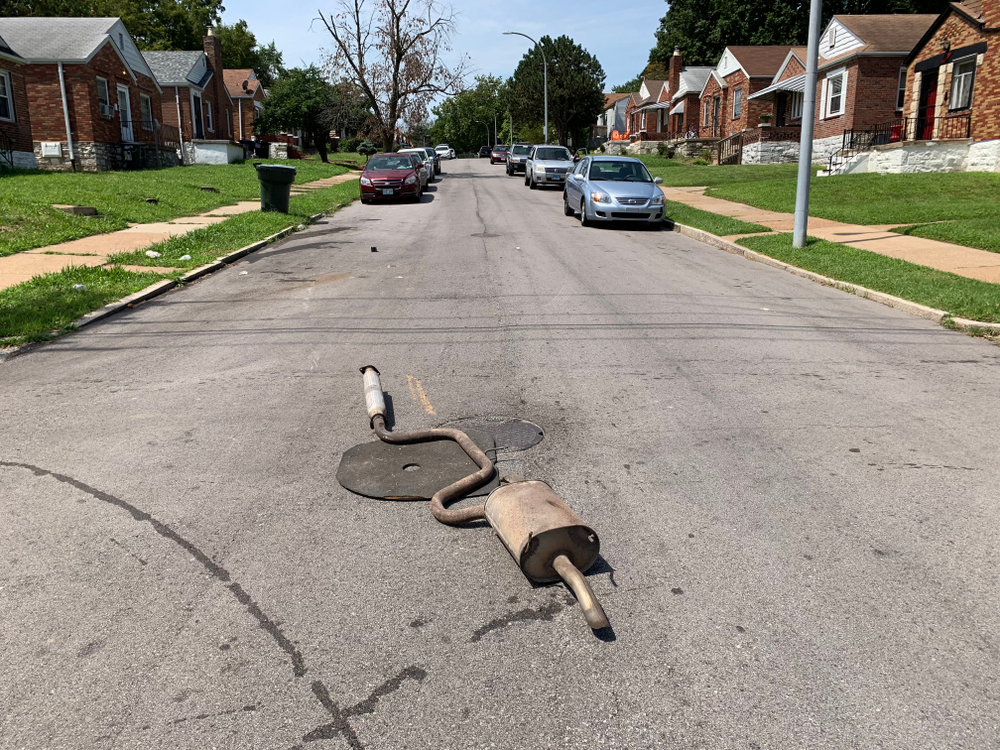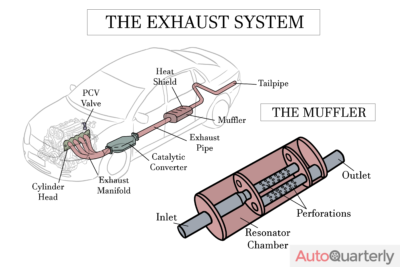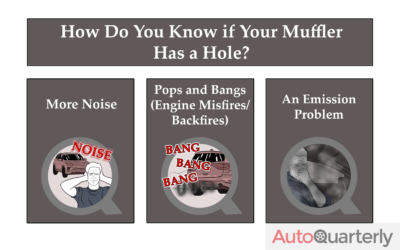We all know that cars can be a real pain in the backside to take care of. They have so many different parts and each one seems to have about 20 different things that can go wrong with it. The end result often leads you to get stuck footing the bill or maybe even footing it home from the middle of nowhere when it breaks down.
But, for the vast majority of people in the US, a running car is a necessity for daily life. And that means we have to learn how to best take care of our vehicles to keep them in working condition for as long as possible.
If you’re reading this, then you must have a hunch that your car’s muffler is going through a bad time. Let’s start off by getting everyone on the same page by going back to the basics with one simple question: What is a muffler?
What Is a Muffler? (And What Does It Do?)
Mufflers, also called silencers by some, accomplish two primary goals: noise reduction (muffling) and exhausting gases. Mufflers are necessary pieces of equipment that make sure you don’t get pulled over for noise pollution, while also ensuring the engine can operate efficiently.
Put simply, internal combustion engines harness the power of explosions to make your car move. This process creates a lot of noise, while also producing fumes (called exhaust) as a byproduct. These exhaust fumes will impede the engine’s performance, which requires fresh oxygen to fuel the combustion process.
Exhaust fumes that aren’t pulled out of the system will choke off the whole combustion system and impact performance. We all learned in middle school science that fires can be smothered out by removing oxygen from the system. This same principle applies to internal combustion engines.
Worse still, a malfunctioning muffler can actually be quite dangerous for you and any other occupants in your car. A damaged muffler can result in engine exhaust seeping into the cabin of your vehicle. The exhaust fumes produced by your car are full of toxic carbon monoxide, an odorless and colorless gas that can lead to headache, fatigue, nausea, dizziness, difficulty breathing, confusion, and even death.
How Do You Know if Your Muffler Has a Hole?
Invisible, odorless, deadly gas is certainly a terrifying prospect. But proper maintenance, and the simple act of paying attention to your car as you drive, go a long way in noticing issues before they develop into something that may be life-threatening or damaging to other parts of your vehicle.
While mufflers can develop massive, rusted holes that would be hard to miss, like in the photograph below, there are some key symptoms of holes forming in your muffler that you should be on the lookout for to detect the problem before it gets this bad.
More Noise
One of the primary purposes of a muffler is to, well, muffle. Mufflers that are in good working order do a great job of reducing the noise that comes from your engine. If you notice an increase in the volume output of your car’s engine, there’s a good chance something is wrong.
Pops and Bangs (Engine Misfires/Backfires)
Remember how mufflers are responsible for two primary tasks: reducing engine noise and removing the exhaust from the engine’s system? Well, a hole in your exhaust system can cause your vehicle’s oxygen sensor to malfunction, resulting in extra fuel being sent to the engine. This fuel may come into contact with oxygen making its way through the holes in your exhaust, causing a backfire.
The good news is that this symptom is one of the easiest to spot. If you’re driving, and you haven’t modified your vehicle in any way, you’ll hear sounds that resemble gunshots. While this may frighten the people around you, it’s a great way to know if you have a hole in your muffler.
An Emission Problem
Many, but not all, states require regular emissions testing for the vehicle to be deemed road-worthy. A damaged exhaust system can allow emissions to escape before they are supposed to. This can result in excess pollutants if the hole is near the catalytic converter, which is the part of the exhaust system that comes before the muffler. The catalytic converter is responsible for cleaning up some of the toxic gases before they are released through the muffler.
A hole in your exhaust pipe can allow toxins to seep into the air before they are properly treated. This can also allow exhaust fumes to seep into the cabin of the vehicle as we mentioned above—posing a serious health risk to you and any passengers you may have.
What Causes Holes in Mufflers?
Modern mufflers are designed to last for the lifetime of the vehicle but that doesn’t mean they’re immune to degradation and damage. Exhaust systems, including the muffler, are made from a material called aluminized steel, which is steel with an aluminum coating designed to provide corrosion resistance. However, that doesn’t mean mufflers are immune to corrosion and rust.
One of the main culprits behind rusting mufflers (which often leads to holes forming as the rust worsens) is salt. This means driving in winter conditions on roads that are salted to prevent ice can result in salt bouncing off the road and tires onto the underside of your car where the exhaust system is. Living near the ocean can also cause rust to form faster than in other locations due to the salt in the air.
Mufflers can also get damaged by rocks and road debris bouncing up into the undercarriage of your vehicle, causing dents, cracks, and holes to form. Water pooling in your exhaust system can also cause the rusting process to be sped up, which is why mufflers are often designed with small perforations to allow for moisture to escape.
Once your muffler begins rusting, corroding, and cracking, the situation is likely to only degrade over time. However, there are some DIY fixes you can do to potentially save yourself from needing to replace your muffler or exhaust system altogether.
How to Fix a Hole in a Muffler?
There are a variety of products and methods for fixing a hole in a muffler. Ultimately, the best option for you depends entirely on the extent of the damage present. If your muffler is developing large rust spots or cracks, it’s almost certainly going to need to be replaced. However, some of the repair products (or a combination of them) we’re about to talk about could help your car last long enough to get a proper repair job done.
FiberFix Heat Wrap
First up in our list of muffler repair products is the easiest one to use: FiberFix Heat Wrap. This handy product is basically like a roll of duct tape on steroids. Simply submerge the whole roll in water for about five minutes and then wrap this stuff completely around the damaged area of your exhaust pipes with a firm hand tightening the wrap as you go. It will take a few hours for the wrap to cure and harden with drying time varying based on temperature.
Dynomax Muffler Cement
Dynomax’s Muffler Cement is great for covering small cracks and fixing seals where pipes are fitted together. It cures in just a few minutes and can be used to bond patches over damaged mufflers.
J-B Weld ExtremeHeat Metallic Paste
J-B Weld’s ExtremeHeat Metallic Paste is used as an alternative to welding with a torch, making it perfect for DIYers who don’t have the knowledge or tools for true welding work. This paste sets in just a few minutes and will cure after several hours—allowing for drilling, sanding, and machining if necessary.
J-B Weld HighHeat Epoxy Putty
Another J-B Weld product that made our list is this J-B Weld HighHeat Epoxy Putty which you mix by cutting off the desired amount and then kneading the two-part epoxy into a uniform color. Then you just mold and press the putty into place over the damaged area to seal it off. It sets in 1 hour and cures in about 8.
All four of these products are designed specifically for exhaust pipes and mufflers thanks to their high heat tolerances. Exhaust pipes can get quite hot during the normal operation of your vehicle, so it’s imperative that your repair job is able to withstand high temperatures to avoid issues from happening while on the road.

Closing Thoughts
Modern mufflers are designed to last for the lifetime of your vehicle, but certain conditions (especially high concentrations of salt) can cause mufflers and your exhaust system to rust and become damaged over time. While you can patch a hole in your muffler at home with some DIY tools and products, it’s likely that the patch job will only be a temporary fix.
Ultimately, replacement of your muffler or other damaged parts is likely to be necessary. Still, keeping an eye on damage as it occurs and doing your best to perform regular maintenance and inspections will help keep you and your passengers safe while also improving the lifetime of your vehicle and reducing repair costs. So, keep an eye and an ear out for any new developments and always be sure to buckle up and drive safe.




